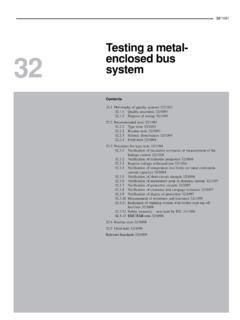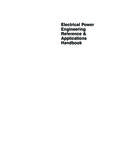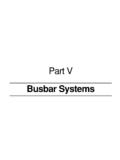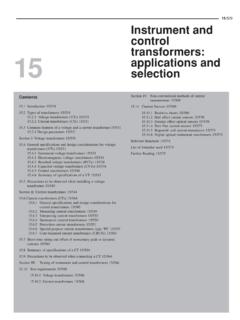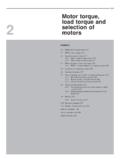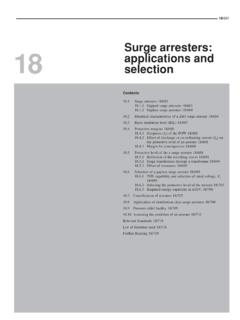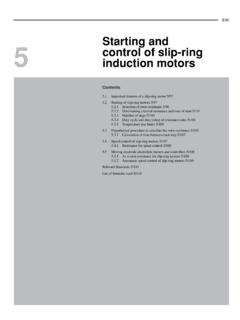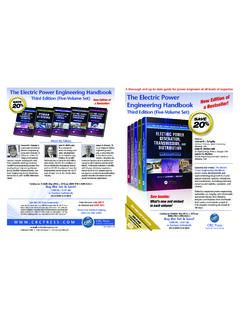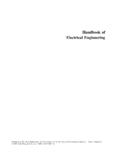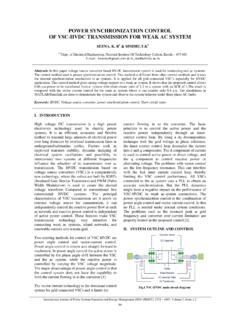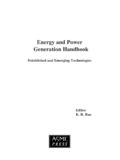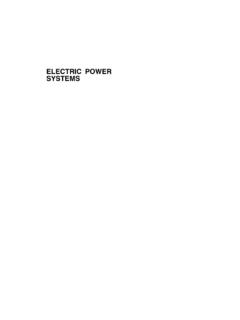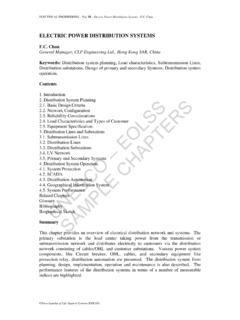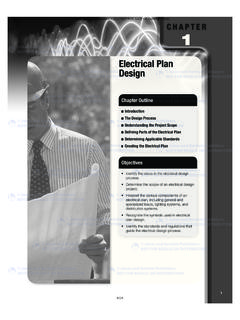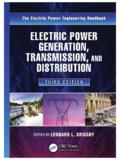Transcription of Contents
1 Properties for aluminium and copper conductors 30 Important definitions of properties of a metal 30 Physical and mechanical properties 30 electrical properties 30 Measuring the conductivity 30 Current-carrying capacity of copper and aluminium conductors 30/1054 Copper sections 30/1055 Aluminium sections 30/1059 Relevant Standards 30/1065 Further Reading 30/106530 Properties andratings of current-carryingconductors30/1049 Properties and ratings of current-carrying conductors30 Properties for aluminium andcopper conductorsIn Table we provide the general properties ofaluminium and copper conductors. The table also makesa general comparison between the two widely used metalsfor the purpose of carrying Important definitions of properties of a metalFor ease of application of the above table we give belowimportant definitions of the mechanical and electricalproperties of a Physical and mechanical properties1 Specific heat (This is a physical property) The specificheat of a substance is the heat required to raise thetemperature of its unit mass by 1 is the force per unit area expressed in kgf/mm2and is represented in a number of ways, dependingupon the type of force applied, Tensile stress.
2 The force that will stretch or lengthenthe material and act at right angles to the areasubjected to such a force. Ultimate tensile strength: the maximum stress valueas obtained on a stress strain curve (Figure ). Compressive stress: the force that will compressor shorten the material and act at right angles tothe area subjected to such a force. Shearing stress: the force that will shear thematerial and act in the plane of the area and atright angles to the tensile or compressive stress. Modulus of elasticity (E): the ratio of the unitstress to the unit strain within the proportionallimits of a material in tension or compression. Proportional limit: the point on the stress straincurve at which will commence the deviation inthe stress strain relationship from a straight lineto a parabolic curve (Figure ).
3 Elastic limit: the maximum stress a test specimenmay be subjected to and which may return to itsoriginal length when the stress is released. Yield point: a point on the stress strain curvethat defines the mechanical strength of a materialunder different stress conditions at which a suddenincrease in strain occurs without a correspondingincrease in the stress (Figure ). Yield strength or tensileproof stress: themaximum stress that can be applied withoutpermanent deformation of the test the materials that have an elastic limit (somematerials may not have an elastic region) thismay be expressed as the value of the stresson the stress strain curve corresponding to adefinite amount of permanent set (elongation)of, say, or of the test propertiesResistivity of metal of a current-carrying conductorA metal being used for the purpose of current carryingmust be checked for its conductivity.
4 This is proportionalto its current-carrying capacity. This will ascertain thecorrectness of size and grade of the metal chosen for aparticular duty. It is necessary to avoid over-heatingof the conductor during continuous operation beyondthe limits in Table The electrical conductivity of ametal is reciprocal to its resistivity. The resistivity maybe expressed in terms of the following units: Volume resistivity or specific resistance: this is theresistance of a conductor of unit length and unit cross-sectional area, mm2 or W m (or m W m)and 1 cm = 10 mmm22m WW Mass resistivity: this is the resistance of a conductorof unit length and unit mass; W gm/m2which is also equal to the volume resistivity multipliedby the (W m) (gm/m3) = W gm/m2 Length resistivity: this is the resistance of a conductorper unit length, W/m.
5 Conductivity: therefore, the electrical conductivitywith reference to say, volume conductivity, can beexpressed bym m2W or 1 mW resistivity and conductivity of standard annealedcopper and a few recommended aluminium grades beingused widely for electrical applications are given in Their corresponding current-carrying capacities inYield pointElastic limitProportional limitUltimate tensilestrengthStressStrain** Tensileproof strength = to of ultimate tensile strengthFigure strain curve30/1052 electrical power engineering reference & Applications HandbookTable properties (average) of copper and aluminium at 20 CParametersStandard copperCommercial purity aluminium (for electrical use)(IACS)
6 A123 Relevant StandardsIEC 60028 IEC 60105 ISO 209-1,2 Standard grades(a) As in BS100% IACSEIEc MbHE9c WPbE 91Ec(b) As in BS 2898 (ISO 209-1) 13506063 A6101A(c) Equivalent Indal grades CIS Mb50S WPbD 50S WPbPhysical properties(a) Chemical compositionCopper (Cu)%Cu, Si, Fe Not more than (Mg)% (Si)% pureMg, Cr, Sn, Zn and Mn (Fe)% , Ti, Zn and Mn% Rest is all aluminiumSpecific (gm/cm3) point( C)1083660 Mechanical propertiesUltimate tensile strengthkgf/mm222 to shearing strengthkgf/mm216 to of elasticity Ekgf/mm212, tensile-proof strengthkgf/mm260 80% of the 11 strengthElectrical propertiesVolume resistivity or specific resistance (r)(a) in m W (b) in mmm2W 10 10 10 2 10 10 2 Properties and ratings of current-carrying conductors30/1053 Volume conductivitym/W IACS*10061/6050/4855 Temperature coefficient of electrical resistanceper C (applicable over a working range 10 10 3 10 10 3 10 10 3100 200 C)a20 at a particular conductivity= a20 at 100% conductivity actual conductivityof the metalCoefficient of linear expansion (thermal),(mm/ C) 10 10 10 10 5(applicable over a working range of 20 200 C)
7 Mass resistivity = volume resistivity density (m W gm/cm2) When using the above metals for the purpose of current carrying, their mechanical suitability must be checked with the data provided above to withstand, without permanent deformation,the electrodynamic forces that may develop during a short-circuit condition (Section ).2 For important definitions, refer to Section These values are based on the mean values of a number of tests carried out on specimens of standard copper and aluminium IACS International Annealed Copper Standardb Suffix M (now F) or WP (now T6) represents the type of EIE, HE9 and E91E are old designations. They have now been replaced by 1350, 6063 A and 6101 A copperCommercial purity aluminium (for electrical use)(IACS)a30/1054 electrical power engineering reference & Applications Handbookper cent, with respect to a standard reference (say, 100%IACS) are also provided in the Measuring the conductivityFor this purpose, a simple conductivity meter based on theprinciple of eddy current may be used for a direct readingof conductivity.
8 The meter operates on the basis of relativevariance, in the impedance of the test piece compared tothe reference standard piece of aluminium or copper havinga conductivity of 100% or m/Wmm2 for aluminiumand m/Wmm2 for IACS (International Annealed CopperStandard) in terms of conductivity unit. The test probes,that sense the impedance of the test piece, induce an eddycurrent in the test piece at a fixed frequency. The magnitudeof this current is directly proportional to the conductivityof the metal. This eddy current develops an electromagneticfield around the test piece and varies the impedance of thetest probe (skin effect). The conductivity is thus determinedby measuring the corresponding change in the impedanceof the probe.
9 Figure shows a simple and portableconductivity Current-carrying capacity ofcopper and aluminiumconductorsEarlier practice was to use copper in most applicationsin view of its rigidity and high conductivity. With theeasier availability of aluminium and being more viableeconomically, aluminium is now preferred whereverpossible. It is employed particularly where the metal hasto simply carry power such as for the transmission anddistribution of power at any voltage and as the maincurrent-carrying conductor in power distribution or controlequipment, such as a bus system or a switchgear , it is also used to feed high currents to aninduction or a smelting furnace, electroplating plant or arectifier plant.
10 For main current-carrying components,however, as required for switching or interrupting devices(breakers, switches, fuses, contactors and relays) copperand copper alloys are preferred. The alloys of copper arecompact in size and are a much harder metal, suitablefor making and breaking contacts frequently and yetretaining their shape and size over long years of is also used for low ratings, up to 100 A or so,required for the internal wiring of power and controlcircuits in a switchgear or a controlgear assembly, wherethe wires have to bend frequently. Aluminium, beingbrittle, is unsuitable for such applications. The use ofcopper is also recommended for areas that are humid,saline and chemically aggressive which may corrodealuminium quickly.
